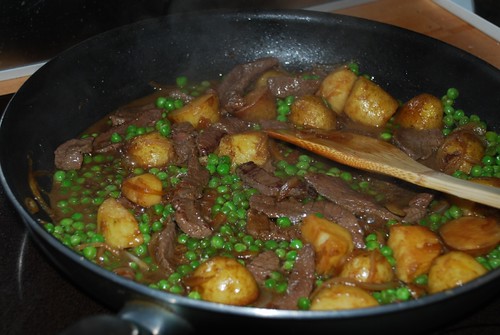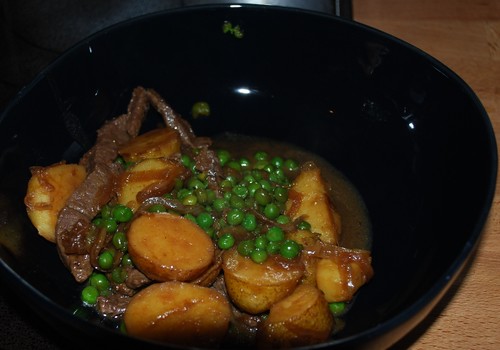Big Bird's Demise
Thursday, 22 May 2008 by kinakoJam

There's no decent butcher close to our place in the Belgischesviertel, so when it comes to red-meat cravings, we usually settle with the most palatable offerings on the shelves of the local Rewe supermarket. And sometimes, that means we find ourselves wondering what to do with several pieces of vacuum-sealed ostrich meat.
Ostrich meat is low fat (a uniform shade, with no marbling) yet does not suffer for this, yielding a strong meaty flavour. I'd hesitate to say 'gamey', although in its raw state it has a fruity blood scent (if you sniff it up close that is). We've found that it is good used in Japanese dishes which require a bit of simmering to soak up the broth, because it cooks evenly, and does not become chewy or sinewy, as good sirloin can do when cooked in this manner.
We kiwis have a certain history with large flightless birds. At one point, it was our native Moa that could lay claim to being the largest living species of bird. But muscle isn't everything, as the Moa discovered to its peril.
Don't know how fast the Moa could run, but the Ostrich's land speed of 65 km/h does not seem to be much use against a fate on our dining tables, either.
Ostrich & New Potato Nikomi (adapted from a recipe by Hiroko Shimbo)
300 g ostrich meat, sliced into strips across the grain (not that there's much grain)
3 tbsp olive oil
2 medium onions, one cut in thin disks, one in thin wedges
2 handfuls of small new potatoes cut into bite size chunks.
1 tbsp sesame oil
1 cup dashi or water (I use powdered kombu/kelp stock from the Japanese supermarket, mixed in water - vege stock could also work)
2 tbsp sake
2 tbsp sugar
1/4 cup shoyu
1 cup or more of fresh or frozen green peas (I'm a big fan of peas)
In a bowl, combine the meat, 1 tbsp olive oil, and the onion disks. Marinate the meat for 30 min.
While it marinates, cook the potatoes in a large pot of boiling water for 8 minutes or until cooked through but still firm. Drain and wipe with paper towel.
Heat a flat pan and add 2 tbsp olive oil. When hot, saute the potatoes, rolling until golden all over. This might take a while the but the golden-browning is worth it. It means they still have a delectable slightly crisp layer even after being simmered in the broth.
Remove potatoes from pan and set aside.
Drain off excess oil, and add sesame oil to pan. Remove ostrich meat from marinade, discarding the onion, add to pan and cook til it turns pale.
Add potatoes and onion wedges and give several large stirs. Add the dashi and sake and bring to a boil. Cook over low heat, covered with a loosely fitted lid or a japanese-style wooden drop lid, for 8 minutes. Add the sugar and cook for a few more minutes, then add the shoyu/soy sauce, and cook until liquid is somewhat reduced (probably just another few minutes). Add the green peas and cook til heated through. Serve hot!
You'll love this umami-filled take on meat & 3 veg.

As cold comfort to animal activists, or those who loved Big Bird on Sesame St, many parts of the ostrich can be utilised, making its demise a bit less wasteful. For instance, the leather can be used for expensive Japanese sneakers.
But maybe the big question should be...... do ostriches fart?
And does Pharell catch the bus to the office where he designs his ostrich Bape Stas? And does he recycle his bus ticket or throw it away, or simply chew it up and swallow it? And how much of his lung capacity does he use?
